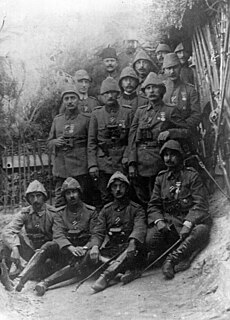| Reserve Infantry Divisions | - Afyon Redif Tümeni: Afyon Redif Alayı (Afyon, Sincanlı, Sandıklı Taburu) Akşehir Redif Alayı (Akşehir, Yalvaç, Bolvadin Taburu)
- Aydın Redif Tümeni: Aydin Redif Alayı (Aydin, Çine, Bozdoğan Taburu) Nazilli Redif Alayı (Nazilli, Karacasu, Sarayköy Taburu)
- Babaeski Redif Tümeni: Babaeski Redif Alayı (Babaeski, Uzunköprü, Hayrabolu Taburu) Çorlu Redif Alayı (Çorlu, Tekirdağ, Çatalca Taburu) Kırklareli Redif Alayı (Kırklareli, Lüleburgaz, Vize Taburu) Keşan Redif Alayı (Keşan, Gelibolu, Malkara Taburu)
- Çanakkale Redif Tümeni: Çanakkale Redif Alayı (Çanakkale, Lapseki Taburu) Pazar Redif Alayı (Pazar, Biga, Karabey Taburu) Biga Redif Alayı (1°, 2° Biga, Karabiga Taburu)
- Denizli Redif Tümeni: Denizli Redif Alayı (Denizli, Hunas, Tavas, Tefenni Taburu) Çivril Redif Alayı (Çivril, Çal, Uluborlu Taburu) Isparta Redif Alayı (Isparta, Burdur, Egridir Taburu)
- Drama Redif Tümeni: Kavala Redif Alayı (Kavala, Bük, Pravişte Taburu) Drama Redif Alayı (Drama, Nusretli, Rakeştan Taburu) Nevrekop Redif Alayı (Nevrekop, Karasu, Razlik, Devlen Taburu)
- Edirne Redif Tümeni: Edirne Redif Alayı (1. 2. 3. Edirne, Mustafa Paşa Taburu) Koşukavak Redif Alayı (1. 2. Koşukavak, Ortaköy Taburu) Dedeağaç Redif Alayı (Dedeağaç, Dimetoka, Sofulu Taburu)
- Elbasan Redif Tümeni: Elbasan Redif Alayı (Elbasan, Libraşt, Gramiş Taburu) Tiran Redif Alayı (Tiran, Erzen, Akçahisar Taburu) Berat Redif Alayı (Berat, Devol, Skrapar Taburu) Draç Redif Alayı (Draç, Kavaya, Peklin, Luşna Taburu)
- Ereğli Redif Tümeni: Ereğli Redif Alayı (Ereğli, Devrek, Gerede Taburu) Bolu Redif Alayı (Bolu, Düzce, Göynük Taburu) Bartın Redif Alayı (Bartın, Çaycuma, Safranbolu Taburu)
- Fatih Redif Tümeni: Fatih Redif Alayı, Süleymaniye Redif Alayı, Hırka-i-Şerif Redif Alayı
- Gümülcine Redif Tümeni: Gümülcine Redif Alayı (1. 2. 3. Gümülcine Taburu) Sultanyeri Redif Alayı (1. 2. Sultanyeri, Kırcaali Taburu) İskeçe Redif Alayı (1. 2. İskeçe Taburu)
- İştip Redif Tümeni: İştip Redif Alayı (İştip, Hotina, Radovişte Taburu) Koçana Redif Alayı (Koçana, Bereketli Taburu) Köprülü Redif Alayı (Köprülü, Babone, Tikveş Taburu)
- İzmit Redif Tümeni: İzmit Redif Alayı (İzmit, Adapazarı, Karamürsel, Şile Taburu) Bilecik Redif Alayı (Bilecik, Geyve, Söğüt Taburu) Eskişehir Redif Alayı (Eskişehir, Seyitgazi, Sivrihisar Taburu)
- Kastamonu Redif Tümeni: Kastamonu Redif Alayı (Kastamonu, Daday, Araç, Taşköprü Taburu) İnebolu Redif Alayı (İnebolu, Cide, Küre-i Nuhas Taburu) Sinop Redif Alayı (Sinop, Ayancık, Boyabat Taburu)
- Kayseri Redif Tümeni: Kayseri Redif Alayı (Kayseri, Erkilet, Boğazlıyan Taburu) Nevşehir Redif Alayı (Nevşehir, Ürgüp, Aksaray Taburu) Develi Redif Alayı (Develi, Tavlon, Niğde Taburu)
- Kırcaali: Kircaali Redif Alayı (1., 2., 3.Kırcaali Taburu) Palas Redif Alayı (1., 2.Palas, Darıdere Taburu) Eğri Dere Redif Alayı (1., 2., 3.Eğridere Taburu)
- Konya Redif Tümeni: Konya Redif Alayı (Konya, Sille, Ilgin Taburu) Seydişehir Redif Alayı (Seydişehir, Beyşehir, Akseki Taburu) Karaman Redif Alayı (Karaman, Ereğli, Bozkır Taburu)
- Manastır Redif Tümeni: Manastir Redif Alayı (Manastir, Resne, Filorina, Ohri Taburu) Pirlepe Redif Alayı (Pirlepe, Kirçova, Kroşova Taburu)
- Mitroviça Redif Tümeni: Mitroviça Redif Alayı (Mitroviça, Yenipazar, Ibre Taburu) Seniçe Redif Alayı (Seniçe, Prepol, Taşlıca Taburu)
- Nasliç Redif Tümeni: Nasliç Redif Alayı (Nasliç, Kesriye, Bihlişte Taburu) Görice Redif Alayı (Görice, Malik, Starova Taburu) Kozana Redif Alayı (Kozana, Serfiçe, Kayalar, Soroviç Taburu)
- Pirizren Redif Tümeni: Gore Redif Alayı (Gore-i Bâla, Gore-i Zir, Luma Taburu) Geylan Redif Alayı (Geylan, Morava-i Bâla, Morava-i Zir, Firzovik Taburu) Prizren Redif Alayı (1. Prizren, 2. Prizren, Şart Taburu)
- Selanik Redif Tümeni: Vodina Redif Alayı (Vodina, Karacaova, Kareferye Taburu) Vardar Redif Alayı (Vardar, Yenice, Gevgeli Taburu) Selanik Redif Alayı (Selanik, Kesendire, Sanayi Taburu) Kelemeriye Redif Alayı (Kelemeriye, Langaza Taburu)
- Samsun Redif Tümeni: Samsun Redif Alayı (Samsun, Çarşamba, Bafra Taburu) Ünye Redif Alayı (Ünye, Perşembe, Fatsa Taburu) Giresun Redif Alayı (Giresun, Ordu, Tirebolu Taburu)
- Serez Redif Tümeni: Serez Redif Alayı (Serez, Nigrita, Demirhisar, Menlik Taburu) Ustrumca Redif Alayı (Ustrumca, Petriç, Osmaniye Taburu) Avrathisar Redif Alayı (Avrathisar, Doyran Taburu)
- İzmir Redif Tümeni: Akhisar Redif Alayı (Akhisar, Sındırgı, Manisa Taburu) Soma Redif Alayı (Soma, Bergama, Dikili Taburu) İzmir Redif Alayı (İzmir, Bornova, Menemen Taburu)
- Uşak Redif Tümeni: Uşak Redif Alayı (Uşak, Eşme, Kula Taburu) Simav Redif Alayı (Simav, Gediz, Emet Taburu) Kasaba Redif Alayı (Kasaba, Demirci, Alaşehir Taburu)
- Selimiye Redif Tümeni: Üsküdar Redif Alayı, Cihangir Redif Alayı, Kasımpaşa Redif Alayı
- Üsküp Redif Tümeni: Üsküp Redif Alayı (Üsküp, Acarlar, Kaçanik Taburu) Preşova Redif Alayı (Preşova, Bilaç, Kumanova Taburu) Kalkandelen Redif Alayı (Kalkandelen, Şar, Gostivar Taburu)
- Yanya Redif Tümeni: Yanya Redif Alayı (Yanya, Aydonat, Filat, Margiliç Taburu) Ergeri Redif Alayı (Ergeri, Permedi, Leskovik, Devline Taburu) Avlonya Redif Alayı (Avlonya, Tepedelen, Fiyer, Malakas Taburu)
|
|---|







